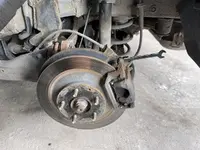Thanks for posting this. I can't tell you how many times I've heard people (mistakenly) state that you aren't ever supposed to turn rotors. This conclusively proves them wrong.
I've been turning rotors for decades, and there's nothing wrong with it. I'd much rather have freshly turned OEM rotors than generic parts store Chinesium rotors.
You did notice the part about "on the car lathe," yeah? A lot of new cars require this nowadays. I know Ford does. Looks like Mazda may as well.
My understanding is that the on-the-car lathe accounts for any runout present in the hub assembly, as well as mounting angle to the brake caliper, and is the only factory-approved method for turning rotors. From talking to techs, and from my own reading, it seems this is mostly due to a couple of reasons, the prime one being that the on-the-car lathe greatly reduces the incidence of runout in the entire assembly, reducing call-backs and warranty work due to customer complaints about shudder and vibrations.
Here are a couple of sources that explain the details better than I could, but keep in mind that both of these are from places selling brake lathes to shops:
Everything you wanted to know about On-the-Car Brake Lathes
Subaru requires the use of an on-the-car brake lathe by its dealers
I heartily agree with the position that putting new pads on old rotors is like installing piston rings without honing the cylinder. My position has been: you might get by with it, but it's a really bad practice. However, here is a source refuting that, if rotors are probably inspected and measured before reuse:
Let the Chips Fly: On-Car & Off-Car Brake Rotor Service. This supports Jmaz's approach as he reported in post #13, and may cause me to re-think long-held beliefs.

But, if I take that position that new pads require a newly-finished rotor surface for proper, long-term operation, and if Mazda requires an on-the-car lathe for refinishing: In my mind it comes down to - which is more cost-effective? In most cases, simply buying new rotors rather than paying a shop to turn them on the car makes the most sense
Now, if you trust your machinist to properly measure and set up for a bench lathe, and if you're meticulous when remounting the rotors and torquing everything, then you're probably fine pulling the rotors and carrying them in to be turned. In practice, what I have done with my kids' Fords is replace the front rotors, which do most of the braking and where vibration is most likely to show up, and have the rear rotors bench turned by the local O'Reillys. This is probably what I'll do with the CX-5 when it his time.


